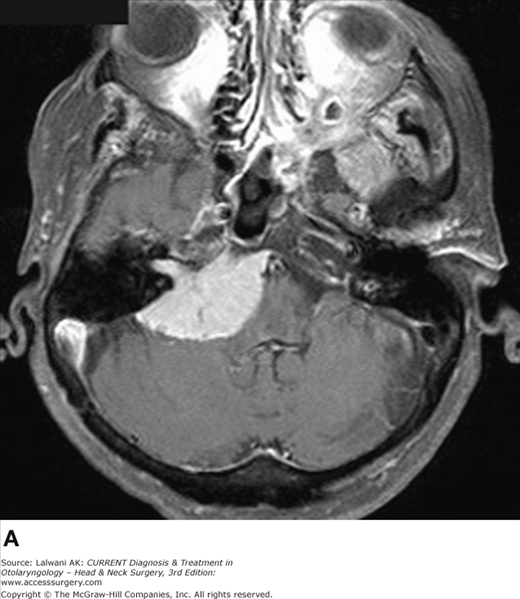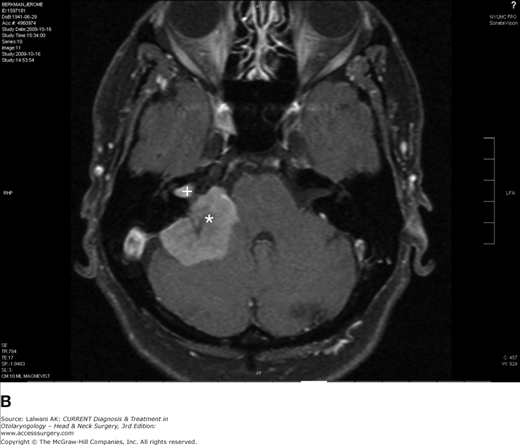Nonacoustic Lesions of the Cerebellopontine Angle: Introduction
Vestibular schwannomas (acoustic neuromas) account for 80% of all lesions of the cerebellopontine angle (CPA). This chapter discusses some of the other common neoplasms (meningiomas and epidermoid cysts) as well as uncommon tumors of the CPA that commonly present with injury to the cochlear–vestibular system. Each of these tumors has a similar clinical presentation; they are primarily differentiated by their imaging characteristics.
The CPA consists of a potential space filled with cerebrospinal fluid (CSF) in the posterior cranial fossa bounded by the temporal bone, the cerebellum, and the brainstem. The CPA is traversed by cranial nerves V–XI and most prominently the facial (CN VII) and vestibulocochlear (CN VIII) nerves. CPA tumors account for 10% of all intracranial tumors (Table 62–1). Nearly 90% of all CPA tumors include vestibular schwannomas (acoustic neuromas) and meningiomas. Other CPA lesions include congenital rest lesions (eg, epidermoid cysts, arachnoid cysts, and lipomas), schwannomas of other cranial nerves, intra-axial tumors, metastases, vascular lesions (eg, paragangliomas and hemangiomas), and lesions extending from the skull base (cholesterol granulomas and chordomas). CPA lesions become clinically symptomatic by causing compression of the neurovascular structures in and around the CPA. The classic description of these symptoms initially includes unilateral hearing loss, vertigo, altered facial sensation, facial pain that later progresses to nystagmus, facial palsy, vocal cord palsy, dysphagia, diplopia, respiratory compromise, and death (Table 62–2).
|
Meningiomas
- Asymmetric (unilateral) sensorineural hearing loss, tinnitus, or both
- More likely than vestibular schwannomas to have facial or trigeminal nerve findings, or both
- Dural tail and calcification are distinctive on imaging.
Meningiomas are the second most common CPA tumors and account for 3–10% of neoplasms at this location. Compared with schwannomas, meningiomas are a more heterogeneous group of tumors with regard to pathology, anatomic location, and treatment outcome. Most of these tumors are benign and slow growing; 1% will become symptomatic. Meningiomas differ in pathogenesis, anatomic location, and imaging characteristics from vestibular schwannomas but are nearly indistinguishable in terms of clinical presentation and audiovestibular testing. Meningiomas are primarily managed by surgical excision.
Meningiomas arise from arachnoid villi cap cells and are located along dura, venous sinuses, and neurovascular foramina. Meningiomas are most commonly sporadic but may occur in familial syndromes such as NF2, Werner syndrome, and Gorlin syndrome. More than one-third of patients with NF2 have meningiomas. Molecular studies have shown deletions in chromosome 22 in nearly 75% of meningiomas. Specifically, mutations in the NF2 gene encoding the merlin protein have been shown in 30–35% of meningiomas. Although most meningiomas are benign, 5% are malignant. Chromosomal abnormalities in 1p, 6q, 9p, 10q, and 14q are seen in more aggressive or malignant meningiomas.
From the onset of symptoms, meningiomas take an average of 5 y to be diagnosed. The typical patient is a woman in her fourth or fifth decade of life. Unlike vestibular schwannomas, there is a 2:1 female bias. Meningiomas presenting in younger patients or multiple meningiomas in the same patient should prompt an evaluation for NF2. The most common complaints are the same as vestibular schwannoma and include unilateral hearing loss (80%), vertigo or imbalance (75%), and tinnitus (60%). The symptoms and signs more common to meningiomas relative to vestibular schwannomas include trigeminal neuralgia (7–22%), facial paresis (11–36%), lower cranial nerve deficits (5–10%), and visual disturbances (8%).
Imaging provides the diagnosis of meningioma and allows the differentiation between meningioma and vestibular schwannoma (Table 62–3).
| Meningioma | Vestibular Schwannoma | |
|---|---|---|
|
|
|
Computed tomography (CT) scanning without contrast shows an iso- or hyperdense mass with areas of calcification in 10–26% of cases and provides information regarding hyperostosis or bony invasion. Meningiomas enhance homogeneously with CT contrast, and 90% of these neoplasms can be detected by contrast-enhanced CT.
MRI is the study of choice for the diagnosis of meningiomas. Meningiomas are hypo- to isointense on MRI T1-weighted images and have a variable intensity on T2-weighted images. Areas of calcification appear dark on both T1- and T2-weighted images (Figure 62–1A and B). Unlike vestibular schwannomas, meningiomas are broad based (sessile) and usually not centered over the porous acoustics. The broad-base attachment to the petrous wall leads to an obtuse bone-tumor angle. There is no widening of the internal auditory canal (IAC). Also unlike vestibular schwannomas, meningiomas more commonly herniate into the middle fossa. T1-weighted enhanced images can show an enhancing dural tail (meningeal sign) adjacent to the bulk of the tumor in 50–70% of meningiomas.
Figure 62–1.
(A) Meningioma of the cerebellopontine angle. A T1-weighted, gadolinium-enhanced MRI scan demonstrates a meningioma of the right cerebellopontine angle. The enhancing lesion has a broad dural base and does not expand the internal auditory canal. (B) Vestibular schwannoma of the internal auditory canal (IAC) and meningioma of the jugular foramen. A T1-weighted, gadolinium-enhanced MRI scan demonstrating an unusual case of small vestibular schwannoma involving the medial IAC (+) and a meningioma involving the lateral IAC, cerebellopontine angle, and jugular foramen (*).
The hearing loss on an audiogram has no characteristic pattern. The speech discrimination scores suggest a retrocochlear pathology in 50% of cases. The auditory brainstem response may be normal in 25% of cases.
The management options include surgery, stereotactic radiotherapy, and observation. The latter two are indicated in patients with limited life expectancy or in whom the expected morbidity of surgical excision is not justified.
Surgical treatment ideally consists of total meningioma removal, excision of a cuff of surrounding dura, and drilling of the underlying bone. The surgical approach is based on the tumor location and the patient’s hearing status.
In contrast to vestibular schwannomas, the anatomic location of posterior fossa meningiomas is varied. The site of the meningioma is a major determinant of types of morbidity from the tumor and the success of treatment. A simple classification differentiates whether the tumor is medial or lateral to the IAC. Meningiomas medial to the IAC are more common. These meningiomas commonly arise along the inferior petrosal sinus and may involve the petrous apex, the lateral clivus, and Meckel cave. Meningiomas lateral to the IAC involve the sigmoid sinus, the jugular bulb, and the superior petrosal sinus. In an uncommon pattern, meningiomas may be centered on the IAC and most closely mimic a vestibular schwannoma. IAC meningiomas may invade the inner or middle ear. Meningiomas may also be superior to the IAC and considered a midpetrosal meningioma.
Meningiomas lateral to the IAC are approached via a retrosigmoidal approach. The facial nerve in lateral meningiomas is most often displaced anteriorly and so does not lie between the surgeon and the tumor. Therefore, the facial nerve is less traumatized during tumor removal. The retrosigmoidal approach also allows for hearing preservation. Limited intracanalicular meningiomas may be managed by the middle cranial fossa approach, especially if hearing preservation is possible. Meningiomas involving the IAC in patients with poor hearing are approached via the translabyrinthine approach. If the tumor invades the cochlea and has an anteromedial extension to the clivus or Meckel cave, then a transcochlear approach should be considered. The transcochlear approach sacrifices hearing and requires rerouting of the facial nerve. Sixty percent of CPA meningiomas involve the middle fossa and may require a craniotomy of the combined middle and posterior fossae. The type of posterior fossa craniotomy in the combined approach depends on the need for hearing preservation and the extent of the surgical exposure required.
Stay updated, free articles. Join our Telegram channel

Full access? Get Clinical Tree




